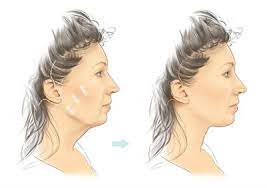Face Implants
A face-lift, also sometimes known as a rhytidectomy, is used to address age-related problems with the lower half of the face, from the eyes and ears downwards. Anything above the eyes is treated with a brow lift.
A face-lift involves elevating and repositioning the skin and soft tissue of the face. During the procedure, cuts are made in front of the ear, extending up and forward along the hairline; redundant skin is then removed, and the remaining skin is hitched and re-draped over its new foundations and sewn into position. Fat and tissue are redistributed and sometimes added to the face.
Facelifts are generally successful procedures and can have dramatic results, often setting the clock back about ten years. However, patients need to be aware that no face-lift will ever make them look 18 again, and you should be aware of the limitations before you agree to undertake surgery. Brow-lifts, for example, which use the same surgical principles and techniques as craniofacial surgery, allow access to the upper face and have different effects.
- Facelifts are commonly performed with local anesthesia and sedation.
- The operation takes between two to five hours, and patients are likely to need to stay in hospital overnight.
- Pain is not a major problem with facial surgery, and complications arising from facelifts are never usually very serious. However, all patients need to be aware that there is a chance of sustaining damage to the facial nerves.
- This can cause weakened movement of the eyebrow and lip, although such repercussions are not common and generally improve over several weeks.
Following surgery, patients commonly experience:
- Feelings of tightness when opening mouth
- Swelling and bruising
- Feeling low and depressed in the first week
- Discomfort at night (sleeping upright with ice packs applied to cheeks is recommended)
Stitches can be removed and after ten to fourteen days patients can think about returning to work or going out in public.
Within four weeks, you will be feeling more like yourself, albeit a younger-looking version. However, patients are advised not to judge the final result of a face-lift for about six to nine months.

